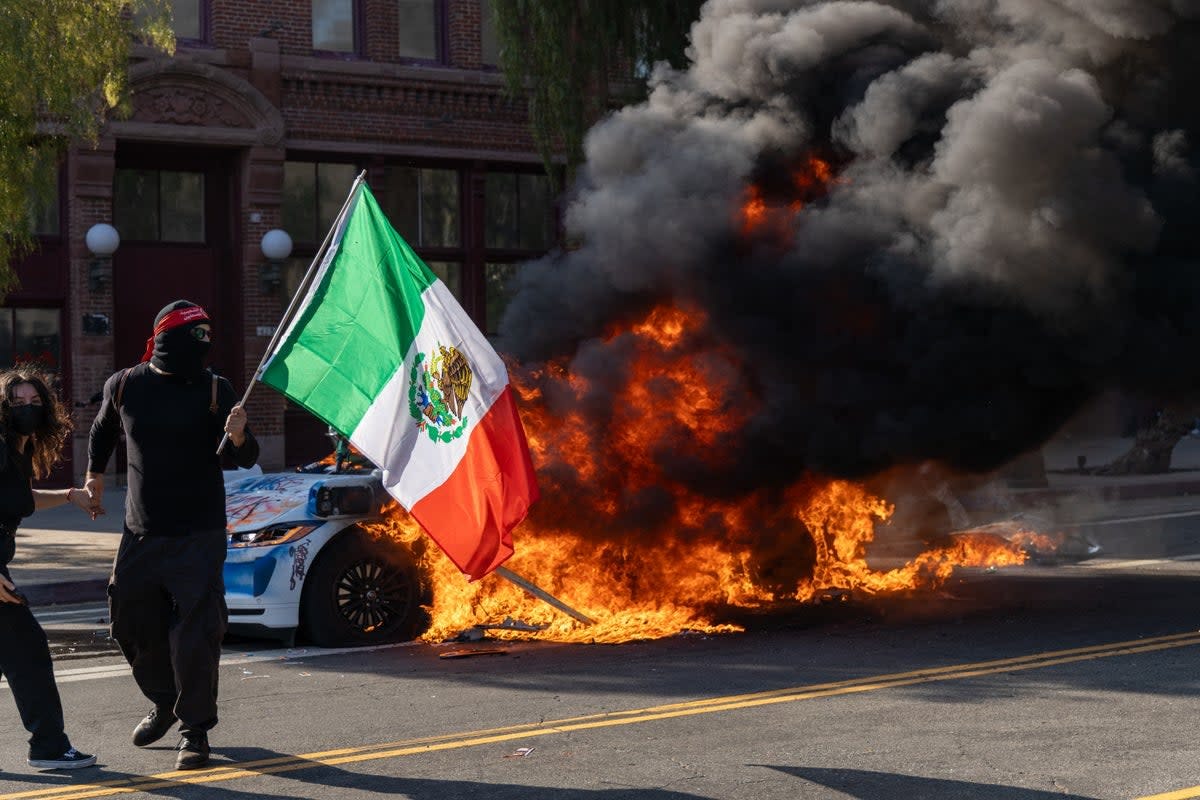A Path Through the Spiralling Immigration Conflict
Nonviolent protest is the key. We’ve compiled some tips — BCB #152
In the last week, protesters in Los Angeles, and subsequently across the country, took to the streets to decry Trump’s immigration crackdown. While raw deportation numbers under Trump remain lower so far than under Biden (due to fewer encounters near the border), the approach has become more aggressive and less legal. People are being arrested at work and at immigration hearings, and the Supreme Court has ruled that many have been deported without due process.
This is worth protesting. It’s such a troubling turn that some previously supportive voters are starting to be disturbed by this administration’s approach to immigration.
Seeing our fears confirmed
The protests in Los Angeles—and images that have subsequently spread online—have created a maelstrom, all the more so since Trump announced that the National Guard and the Marines would be deployed to quell unrest. But differing interpretations of these events will probably push people in starkly opposing directions. As Omar Wasow, a scholar who studies protest, told Politico:
So there’s evidence for either side to make a story that’s consistent with their prior beliefs. And so if your frustration with the liberal media in the era of George Floyd was, “They’re telling me these events are peaceful, but I just watched the Minneapolis Police Station go up in flames,” this is more evidence of how the radical left is engaging in violence and is hypocritical when they say “We are peaceful, but January 6 was violent.”
As people are pushed to their corners, the event can be read in a way that affirms a conservative story. And of course, from the liberal side, there’s lots of evidence of excess force by the state like, “Why are they shooting flash bangs and tear gas?” There’s this clip of an officer shooting a reporter, which is one more step in any kind of authoritarian transition. In that sense, if you believe that, then militant resistance to this repressive set of policies is justified.
That’s all to say, there was and still is a lot of contention in whether the Floyd protests were violent or nonviolent.
(More on that contention. It’s so controversial that it’s unfortunately central to any discussion of protest violence.)
It’s hard to hold on to complex reality at a moment when tensions are running so high. If you’re reading this you’re probably pretty politically engaged, which means you probably have strong feelings about who is in the right. But as Isaac Saul wrote for Persuasion,
I’ve been to many protests as a reporter, and they are never clashes between pure, ideologically motivated activists on one side, and peacekeeping police officers trying to protect their communities on the other.
…
Would I be a hare-brained liberal if I pointed out that so many of these purportedly lazy, criminal, leeching-on-society illegals are getting arrested at work or at their immigration hearings? If dangerous criminals are invading our country, I wouldn’t expect ICE to be arresting them at locations such as these. It’s a hard thing not to notice.
Would I be a cold-hearted fascist if I thought the police in Los Angeles were right to clear the streets from mobs blocking major highways or lighting cars on fire? I mean, there is protesting, and then there is shutting entire city highways down, burning vehicles, vandalism, and so on.
History suggests that militarized responses to protests are likely to escalate the situation. And politically speaking, such escalation is likely to benefit Trump.
Media, perception, and violence
Consider how images of people in black waving foreign flags in front of burning cars will be received by the 48% of Americans who support bringing in the military to restore order:

Whether or not this image is a reasonable representation of the protests – most people don’t wear black, there are plenty of other photos, and only five people have been charged with violent offenses – it’s these sorts of images that are shaping the narrative.
Why do violent images become representative? In part, it’s far easier to photograph a burning car than ICE agents dragging a woman from her workplace. Violence is legitimately newsworthy because it can be important to know about, but it also just makes a more captivating image. Journalists have long tried to balance this sensationalist impulse with accurate representations of the majority of protestors. However, they face a dilemma: fiery images will spread on social media anyway, and underplaying protestor violence can give the impression that reporters are trying to hide information for ideological reasons. This was a radicalizing dynamic in 2020.
However, protestors do have some measure of control over their public perception. This doesn’t happen by accident; it takes organizing and discipline. Merely saying that those involved in violence “aren’t with us” doesn’t work.
While certain leftist groups are advocating violence as a strategy, there’s strong evidence that non-violence is more effective for effecting political change. Historically speaking, major political changes have often come when security forces were sympathetic to the protestors’ cause. What will the National Guard or the Marines do if they’re ordered to crack down on civilians? It will be much harder for them to hesitate if they perceive the protestors as legitimately threatening.
How to maintain non-violent discipline in your movement
Non-violence doesn’t just happen, it requires organization and training. The Center for Applied Nonviolence has a helpful series of trainings on fostering and maintaining nonviolence in the face of escalating tension. These include safety resources to consult before a demonstration, training materials for marshals tasked with leading protests in an orderly fashion, and guides for how to engage allies.
How to protect nonviolent movements from provocateurs
Throughout history, social movements have contained their share of infiltrators, agent provocateurs who spur other people to be violent or act illegally in order to harm the cause. A recent issue of the Anti-Authoritarian Playbook offers helpful tips for those involved in protest to proactively prevent bad actors from setting things back.
Legal advice for military personnel
The secretary of defense has ordered 700 Marines to stand by in California. American troops are normally prohibited from engaging in domestic law enforcement – this is the fundamental difference between police and military. Trump’s deployment of Marines is debatably legal.
The GI Rights Hotline provides confidential legal support for military personnel who believe they may have been given an illegal order.
Quote of the Week
Has anyone at least tried the Kendall Jenner approach and gave ICE some Mexican Coke?





Thanks for your reply to my comment. I realize that I allowed my general support for the President's strong law enforcement effort on illegal immigration to influence my initial response to your post and I simply misread your observation on the Court and due process. Clearly you have done your homework and I was too sloppy in my response. We are both concerned that the concept of due process be understood as meaning that individuals are entitled to certain protections provided by the legal system under the Constitution. The real issue is what they are thus due. I am more inclined that you to think that those who have brokern the law by entering the country illegally are due a lot less than they are demanding and that the courts are finding,
I read your post again and I wonder if you see any limits to non-violent protest other than the requirement not to be violent. What about not to be disruptive of normal life in a city? Personally I get some pleasure out of watching the you tube video of citizens not allowing protestors to block their access to highways. Here we have people refusing to let a few dictate use of public roads. Perhaps I would tolerate a brief blockade but that is my limit of tolerance.
"In the last week, protesters in Los Angeles, and subsequently across the country, took to the streets to decry Trump’s immigration crackdown. While raw deportation numbers under Trump remain lower so far than under Biden (due to fewer encounters near the border), the approach has become more aggressive and less legal. People are being arrested at work and at immigration hearings, and the Supreme Court has ruled that many have been deported without due process."
You need to be a lot more careful in your use of language, especially in your opening paragraph that I just quoted. First of all there is no such thing as "Trump's immigration crackdown" Whateverit is it is not a crackdown on immigration -it is an enforcement action against illegal immigrants. It is not a crackdown unless you want to argue that every law enforcement action is a crackdown and thereby raise doubts about their legitimacy. Finally I should note that it is simply not correct to say that the Supreme Court has ruled that people may be deported without due process.In fact the SC ruled that the legal process followed in specific cases was all that the illegal immigrants were due. If you want to attract serious readers please try to avoid mistakes like the ones in this paragraph.